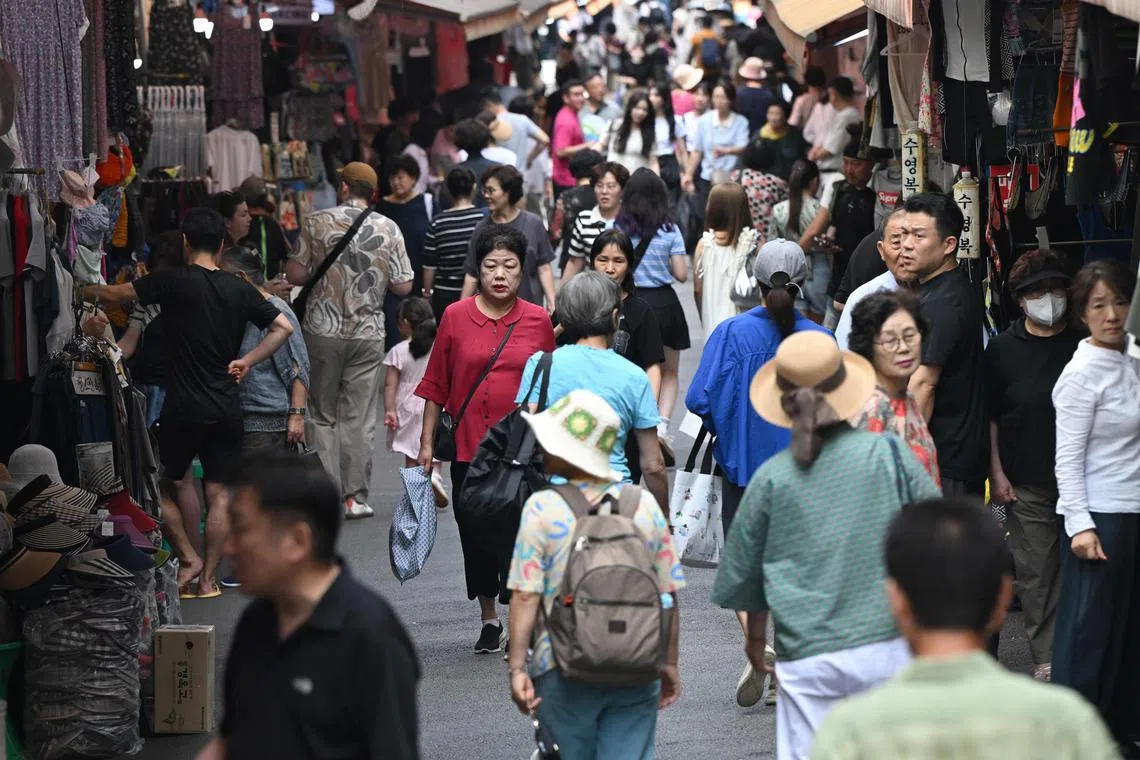South Korea sees economy performing weakest since pandemic shock
Sign up now: Get ST's newsletters delivered to your inbox

South Korea's government projected the export-reliant economy will grow 0.9 per cent in 2025,
PHOTO: AFP
Follow topic:
South Korea projected sluggish growth in 2025 that would mark the slowest pace since the pandemic-induced contraction of 2020, as US tariffs are likely to upend commerce in the months ahead.
The government projected the export-reliant economy will grow 0.9 per cent in 2025, a forecast that is slightly above the 0.8 per cent estimate issued by the Bank of Korea (BOK) in May.
Exports remained mostly resilient in the first half as South Korean manufacturers front-loaded shipments ahead of higher US tariffs, according to a joint government statement on Aug 22.
However, exports may weaken now that a trade deal with Washington was reached in late July, the statement said.
Statistics for the first 20 days of August showed exports to the US fell 2.7 per cent, indicating a loss of momentum after they rose 1.4 per cent in the full month of July.
The forecast underscores the fragile state of Asia’s fourth-largest economy as it slowly recovers from one of its worst political crises, triggered by former president Yoon Suk Yeol’s failed attempt to impose martial law.
As a key player in semiconductors, autos and advanced technologies, South Korea’s growth will ripple across global supply chains, offering a leading indicator for global growth.
The authorities continue to monitor economic trends with a view to adding stimulus as needed. Economists have mixed views as to whether the BOK will lower its benchmark rate when it next sets policy on Aug 28, but governor Rhee Chang-yong said after July’s meeting that four members of the board were open to another cut in the coming months.
The Parliament and Cabinet approved a 31.8 trillion won (S$29.4 billion) extra budget in July as new President Lee Jae Myung sought to insulate the economy from trade headwinds, and the government said this week that it will roll out a support package worth 45.8 trillion won to bolster supply chain resilience.
South Korea remains heavily reliant on exports, raising risks as it confronts rising protectionism abroad.
It also faces structural challenges at home, including weak construction activity and elevated household debt.
“Our main goal under the current administration is to lift the potential growth rate,” Deputy Finance Minister Yoon In-dae said in a briefing. “There is no room to retreat.”
The economy rebounded in the three months through June after a modest contraction in the previous quarter.
But to reach 0.9 per cent growth for the year, output would need to expand by roughly the mid-1 per cent range in the second half, a goal the ministry conceded will be difficult to achieve.
Separately, the administration seeks to win inclusion in MSCI’s developed markets index within Mr Lee’s term by improving foreign exchange and capital markets, with a detailed road map to be unveiled by the year end by a cross-agency task force.
Employment is forecast to rise by 170,000 in 2025, with gains in services offsetting losses in construction and manufacturing.
Inflation is seen hovering near the central bank’s 2 per cent target as energy prices decline, though the government warned that geopolitical tensions and erratic weather could reignite price pressures.
The current account surplus is expected to reach US$95 billion (S$122.5 billion) in 2025, compared with an earlier projection of US$80 billion, due to reduced import costs from cheaper oil, before narrowing again to US$80 billion in 2026.
Consumer spending is forecast to grow 1.3 per cent in 2025, supported by extra budget measures and rate cuts, though high household debt remains a drag.
Further out, Mr Lee’s administration has unveiled a 210 trillion won fiscal plan for 2026 to 2030, aimed at advancing his core policy pledges across innovation, economic growth, social welfare and foreign policy.
A central focus of the plan is major investment in artificial intelligence, alongside priority funding for biotechnology, healthcare and defence.
The initiative is designed to raise South Korea’s potential growth rate to 3 per cent over the period. BLOOMBERG

